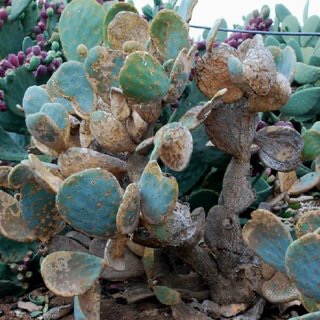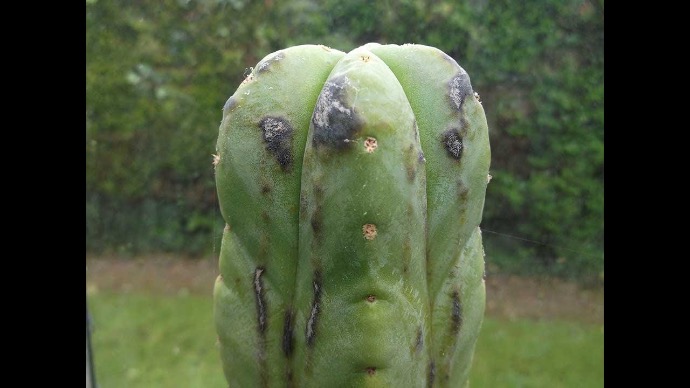Nopales plant
Nopales, perennials, prefer well-drained, sandy soil and full sun. They are frost-sensitive and tolerate dry to moist conditions.
Habit
Perennial
Height
1-2 m
Growth
Fast
Soil
Well Drained, Sandy
Shade
Full Sun
Moisture
Dry to Moist
Edible
Yes
Medicinal
Yes
Origin
Mexico, Americas
Climatic Condition
Desert, Tropical
Temperature (°)
20-30°C
Humidity (%)
40-60%
Potting media
Cactus mix
Fertilizers
Organic, balanced NPK
Watering
Moderate, deep watering
Plant Weight
300-500 g
Flowering Time
Summer, Fall
Soil Ph level
6.0 - 7.0
Water Ph level
6.5 - 7.5
Soil EC
1-2 dS/m
Yield Per Plant
Edible pads and fruit
NPK ratio
5:10:10
life Span
Perennial
Health Benefits
Rich in fiber, vitamins, and minerals
Suggested Grow Media or Potting Mix ?
50% sand, 30% perlite, 20% compost
Suggested Fertigation/Fertilizers
Fertilize every 4 weeks with a diluted cactus fertilizer.
Common Diseases and Remedies
golden scab , black spot
Circular Black spots appears on the plant, Sunken spots, Pale or yellow spots on leaves, dark coloured spots.
Remove infected plants and Neem oil
HEALTH BENEFITS
- Helps manage diabetes by reducing blood sugar spikes.
- Supports weight management due to high fiber content.
- Contains anti-inflammatory compounds that improve gut health.
- Rich in essential minerals like magnesium and potassium.
What Is An Nopales?
Nopales are edible pads made from prickly pear, commonly used in Mexican cooking. It is known for its slightly sour taste and is often added to dishes such as salads, tacos, and scrambled eggs. It is also rich in nutrients such as vitamins, minerals, and dietary fiber. Nopales are the paws or stems of the prickly pear cactus, often eaten as a vegetable in Mexican cuisine. It has a slightly sour taste and is often grilled or boiled and used in dishes such as salads and tacos.

What Are The Different Types Of Nopales?
1. Common Green Nopales
These are the most widespread and commonly used species. It is characterized by its bright green color and slightly spicy taste.
2. Purple Nopals
These nopals have a deep purple hue and are known for their slightly sweeter taste compared to green nopals. It also contains high levels of antioxidants.
3. Thornless Nopals
As the name suggests, these nopals have few or no spines, making them easy to handle and prepare.
4. Wild Nopales
Harvested from the wild prickly pear cactus and varies in size, shape, and flavor depending on growing conditions
5. Baby Nopals
These are young nopals that are harvested when they are still small and soft. It has a mild taste and is often used in salads and stir-fries.

How To Care For Nopales?
1. Location
Nopales are commonly found in Mexico and other parts of Central America. It is also grown in areas with similar climates, such as the southwestern United States.
2. Sunshine
``Sunshine for Nopales'' probably refers to a Mexican dish called ``Nopales a la Mexicana,'' which means ``Mexican cactus.'' A dish made of nopales (prickly pear) cooked with tomatoes, onions, jalapenos, and sometimes cilantro. The name "Sunshine for Nopales" may be a poetic or descriptive expression of the dish's bright flavors and colors, as well as the sunny climate in which nopales typically grow.
3. Soil
Nopales or prickly pear cacti usually grow well in well-drained soils with a slightly acidic to neutral pH. A mixture of sandy soil and organic material such as compost or peat moss is effective. Avoid soil that is too moist as this can cause root rot. If desired, adding perlite or coarse sand can improve drainage
4. Hydration
To rehydrate your cactus pad Nopales, rinse them with cold water to remove dirt and debris. Then boil in water for about 10-15 minutes or steam until soft. Once hydrated, it can be used in a variety of dishes, including salads, tacos, and soups.

5. Nourishment
Nopales or prickly pear paws are rich in vitamins, minerals and fiber. It can be prepared in a variety of ways, including grilling, sautéing, and boiling. You can also add spices like garlic, onion, and chili powder, and herbs like coriander and oregano to boost flavor and nutrition. Pair it with protein-rich foods such as beans and eggs for a well-balanced diet. Plus, incorporate it into salads, tacos, and stir-fries for a nutritious and delicious meal.
6. Issues
Nopales problems vary depending on the situation, but common problems include pests, diseases , nutritional deficiencies, and malnutrition. This includes things like proper watering. Identifying specific symptoms can help you identify the problem and find a solution.
What Are The Benefits Of Nopales
Nutrient Rich Good source of vitamins (especially vitamin C and vitamin A), minerals, and antioxidants. Digestive Health Nopales contains dietary fiber, which aids in digestion and promotes regular bowel movements. Blood Sugar Control Some research suggests that Nopales may help regulate blood sugar levels and may be beneficial for people with diabetes. Heart Health The fiber and antioxidants found in Nopales may contribute to heart health by lowering cholesterol and reducing the risk of heart disease. Anti-inflammatory properties Nopales contains compounds that have been shown to have anti-inflammatory properties and may help reduce inflammation in the body. Weight Management The fiber in Nopales promotes satiety and helps reduce appetite, which may contribute to weight management.

FAQs About Growing Nopales
1. How to maintain nopales plant?
Watering Nopales require infrequent but deep watering. Allow the soil to dry out between waterings to prevent root rot. During hot, dry periods, water more frequently. Sunlight Place the plant in a location with full sunlight. Nopales thrive in bright, direct sunlight. Soil Plant nopales in well-draining soil, such as sandy or rocky soil. Avoid soil that retains too much moisture, as it can lead to root rot. Temperature: Nopales are typically hardy in USDA zones 9 through 11. Protect them from freezing temperatures, as they are susceptible to frost damage. Fertilizing Apply a balanced fertilizer formulated for cacti and succulents once a month during the growing season (spring and summer). Follow the instructions on the fertilizer package
2. What are the uses of nopales plant?
The nopales plant, also known as prickly pear cactus, has various uses Food The pads (nopales) and fruits (prickly pears) are edible. Nopales are commonly used in Mexican cuisine, often in salads, tacos, or as a side dish. Prickly pears can be eaten fresh or used to make juices, jams, and candies. Medicine Nopales are believed to have medicinal properties, including potential benefits for controlling blood sugar levels and reducing cholesterol. They are also used in traditional medicine for treating wounds, inflammation, and gastrointestinal issues. Cosmetics Extracts from nopales are used in cosmetic products for their moisturizing and skin-soothing properties. Animal Feed Nopales can be used as fodder for livestock because of their nutritional content. Dye The fruits and pads can be used to create natural dyes for textiles and other materials. Landscape Ornamentation Some varieties of prickly pear cactus are cultivated for their ornamental value in gardens and landscapes. Biofuel Production Research is being conducted on using nopales as a potential source of biofuel due to their high biomass production and resilience in arid environments.
3. Can I grow nopales plant in indoor?
Yes, you can grow nopales plants indoors, but you'll need to provide them with the right conditions. Nopales prefer bright, indirect sunlight and well-draining soil. Make sure to water them sparingly, allowing the soil to dry out between waterings. With proper care, they can thrive indoors
4. Which pot is best for growing nopales?
For growing nopales, also known as prickly pear cactus, you'll want a pot that provides good drainage and allows for sufficient root space. Terra cotta pots are often recommended because they allow air to circulate through the soil and help prevent overwatering. Additionally, they provide stability for the cactus as it grows. Look for a pot that is at least 12-16 inches in diameter and has drainage holes at the bottom. Make sure to use a well-draining cactus mix for the soil.
5. From where can I shop for nopales plant?
You can shop for nopales plants at local nurseries, gardening centers, or even online plant shops that specialize in cacti and succulents. If you're in an area where nopales are commonly grown, you might also find them at farmers' markets or specialty grocery stores.

